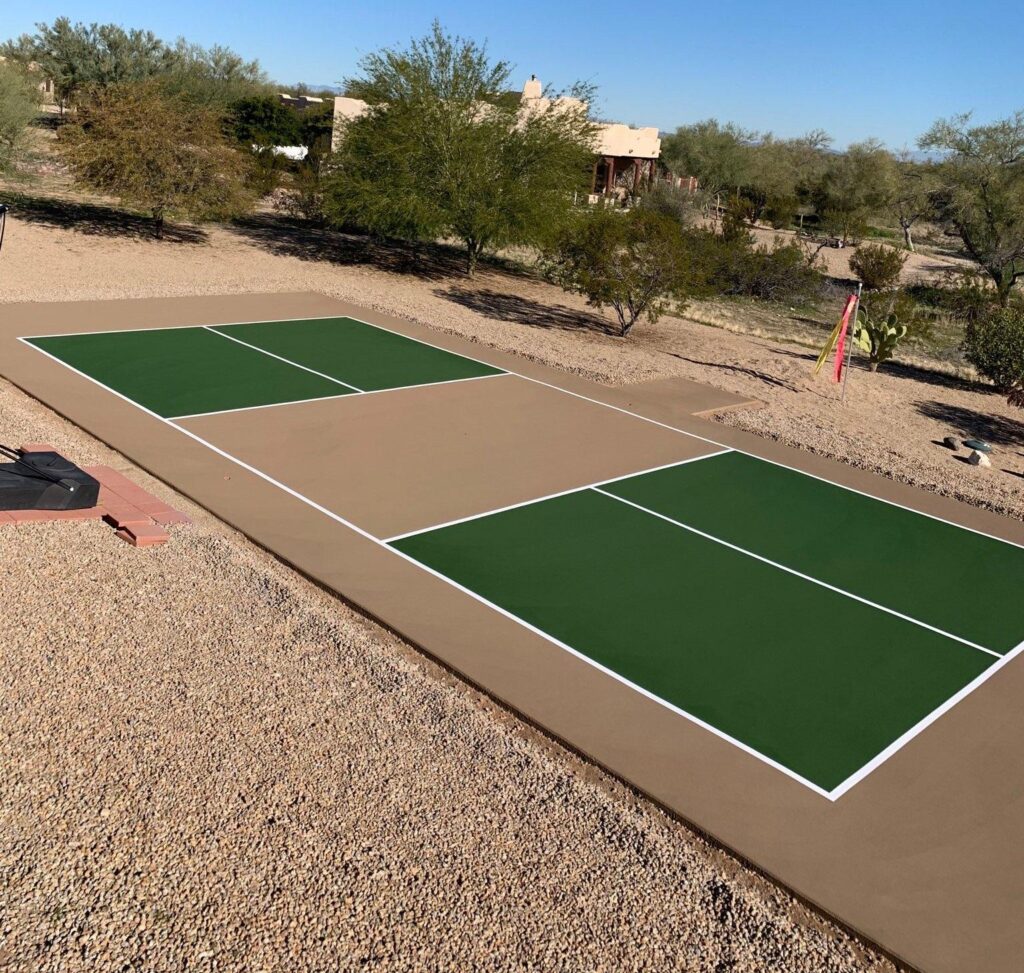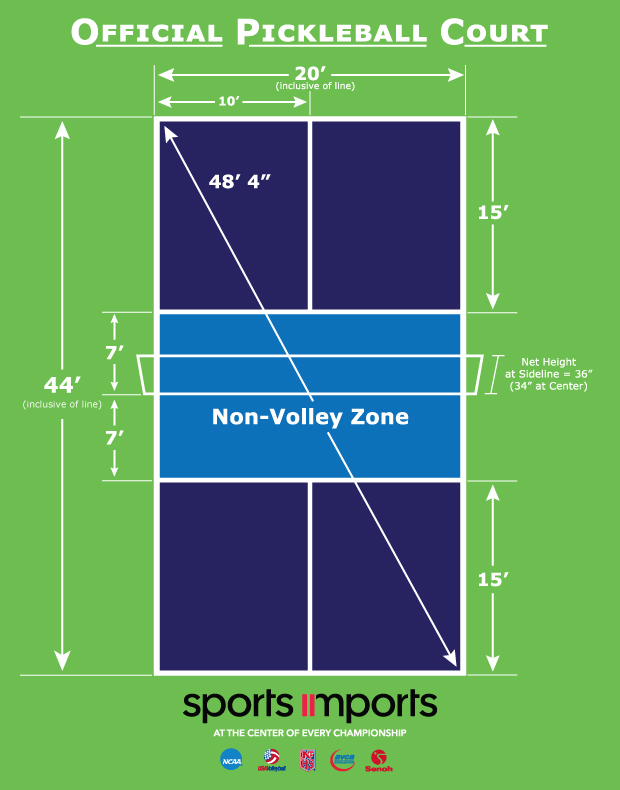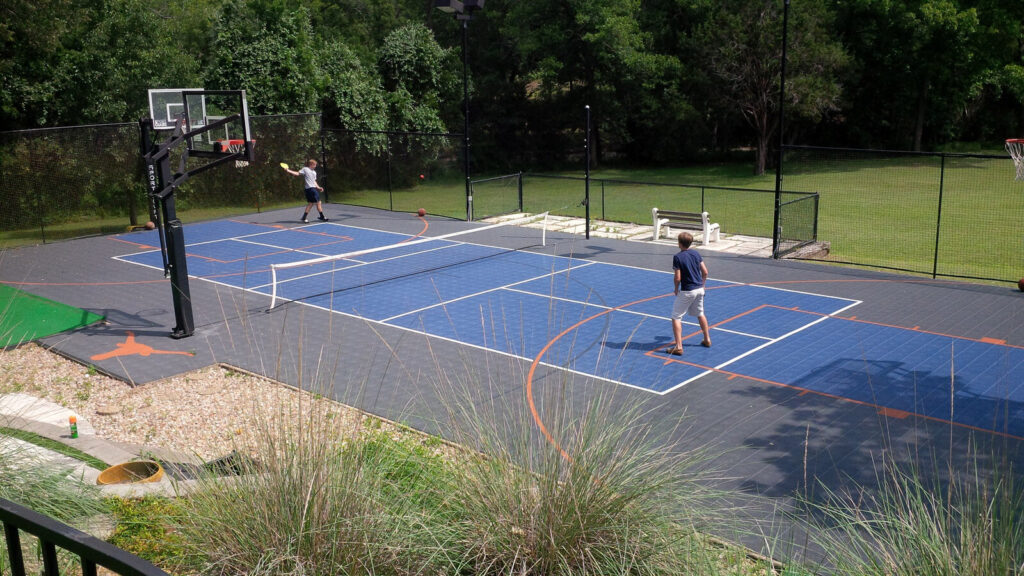To build a pickleball court in your backyard, clear the area, measure and mark the court boundaries, and then install the net and posts. Creating your own pickleball court in the comfort of your backyard can provide endless hours of fun and fitness for friends and family.
From measuring the dimensions to outlining the court boundaries and installing the net and posts, these steps can help you bring the joy of pickleball to your own home. Whether you are a beginner seeking to practice your skills or a seasoned player looking for a convenient place to enjoy the game, a backyard pickleball court can be a fantastic addition to your outdoor space.
With the right materials and proper planning, you can easily create a dedicated space for this fast-growing sport, right in your very own backyard.
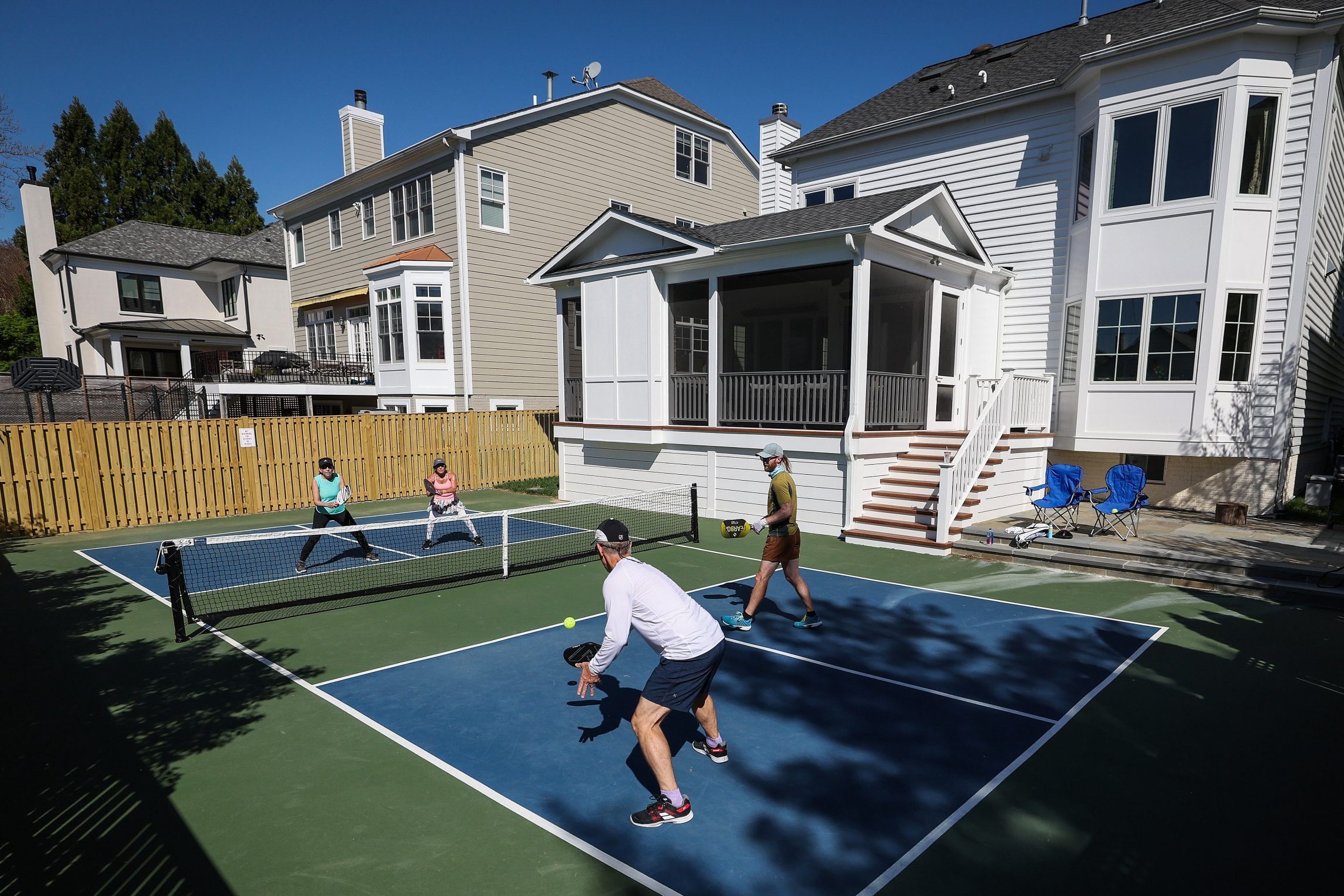
Credit: www.familyhandyman.com
1. Choose The Right Location
When it comes to building a pickleball court in your backyard, the first and most important step is to choose the right location. The location you choose will affect the overall playing experience and ensure the court is safe and enjoyable for everyone. Let’s explore what factors you need to consider when choosing the perfect spot for your pickleball court.
1.1 Consider The Available Space
Before you start planning your pickleball court, it’s crucial to evaluate the available space in your backyard. Pickleball courts have specific dimensions, measuring 20 feet wide and 44 feet long for doubles play, and slightly narrower for singles play. Ensure that your chosen location has enough room to accommodate the court’s size.
Additionally, consider the surrounding areas of the court. Make sure there’s ample space for players to move around without any obstructions. Avoid placing the court too close to trees, fences, or other structures that may interfere with gameplay. Proper spacing will prevent accidental collisions or interference from nearby objects.
1.2 Evaluate The Sun Exposure And Shade
Another crucial factor to consider when choosing the right location for your pickleball court is the sun exposure and shade in your backyard. Aim for a location that offers a balance between sunlight and shade throughout the day.
Excessive sun exposure can make the court uncomfortably hot, which can affect playability and potentially cause discomfort for players. On the other hand, a location with too much shade may result in poor visibility and limit the playing hours due to lack of natural light.
To determine the best position, observe your backyard at different times of the day. Take note of the areas that receive the most sunlight and those that remain shady. By choosing a location that provides a good balance of sun and shade, you’ll ensure an optimal playing experience for yourself and your fellow pickleball enthusiasts.
Remember, choosing the right location for your pickleball court sets the foundation for an enjoyable playing experience. Consider the available space and evaluate the sun exposure and shade in your backyard to make the best decision. Once you’ve selected the perfect spot, you can move on to the next steps in building your backyard pickleball court.
2. Determine The Court Size And Dimensions
When building a pickleball court in your backyard, determining the court size and dimensions is a crucial step to ensure an optimal playing area. Here, we will delve into the standard pickleball court size and how to mark the court dimensions accurately.
2.1 Standard Pickleball Court Size
- A standard pickleball court measures 20 feet wide and 44 feet long for doubles play, with a 7-foot no-volley zone on each side of the net.
- For singles play, the court is the same width but shortened to a length of 34 feet.
2.2 Mark The Court Dimensions
When marking the court dimensions in your backyard, refer to the standard sizes mentioned above. Use tape measures and stakes to ensure precise measurements.
Consider creating a diagram or using string to visualize and plan the court layout before marking the dimensions.
3. Prepare The Ground
When it comes to building a pickleball court in your backyard, preparation of the ground is a crucial step that sets the foundation for the entire construction process. This stage entails clearing the area, leveling the surface, and installing a drainage system to ensure optimal playing conditions and longevity of the court.
3.1 Clear The Area
Clearing the area is the first task in the ground preparation phase. Start by removing any debris, rocks, or vegetation from the designated court area. It is essential to have a clear and clean base to ensure a smooth and even playing surface.
3.2 Level The Surface
Leveling the surface of the court area is crucial to ensure a consistent playing experience. Use a leveler or a grading tool to eliminate any bumps or unevenness, creating a flat and smooth foundation for the court. Proper leveling is essential to prevent water accumulation and ensure safe gameplay.
3.3 Installing A Drainage System
Installing a drainage system is important to prevent waterlogging and maintain the integrity of the court surface. This may involve creating a slight slope to facilitate water runoff, or installing a perforated pipe system to direct water away from the court area. Effective drainage will help in preserving the court and ensuring playable conditions even after heavy rainfall.
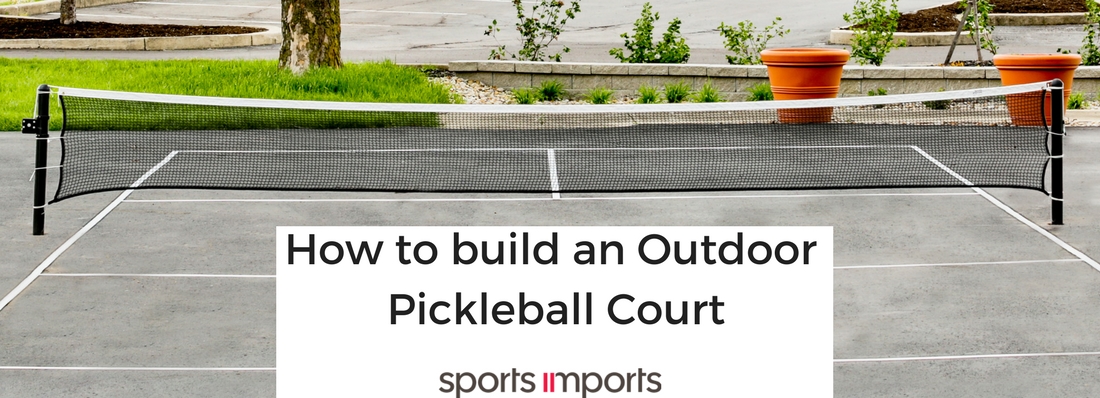
Credit: www.sportsimports.com
4. Build The Frame
Now that you have prepared the ground and gathered all the necessary materials, it’s time to build the frame for your pickleball court. This is an essential step in ensuring a sturdy and well-constructed court that will provide countless hours of enjoyment. In this section, we will guide you through the process, starting with choosing the right material.
4.1 Choose The Right Material
The material you choose for your pickleball court frame is crucial for its durability and longevity. Generally, wood and metal are the two most common options. Here are some factors to consider when making your decision:
| Wood | Metal |
|---|---|
|
|
Ultimately, the choice between wood and metal depends on your personal preference, budget, and DIY skills. Consider the pros and cons of each material before making your final decision.
4.2 Mark The Layout
Before you start installing the posts and beams, you need to mark the layout of your pickleball court. Use measuring tape, stakes, and string to outline the court’s dimensions accurately. Remember that a standard pickleball court measures 20 feet wide by 44 feet long for doubles play, and 20 feet wide by 22 feet long for singles play. Ensure your markings are precise to guarantee a professional-looking court.
4.3 Install The Posts And Beams
With the layout marked, it’s time to install the posts and beams. These components provide the structural support for your court and ensure its stability. Here’s a step-by-step guide:
- Begin by digging holes for the posts at the corners of the court. Make sure the holes are deep and wide enough to support the posts securely.
- Place the posts in the holes and use a level to ensure they are perfectly vertical.
- Pour concrete into each hole to secure the posts in place. Allow the concrete to dry completely according to the manufacturer’s instructions.
- Once the posts are firmly in place, proceed to install the horizontal beams between them. These beams will provide stability and support for the court’s fencing.
- Ensure the beams are level and securely attached to the posts using appropriate hardware.
By following these steps, you will have successfully built the frame for your pickleball court. This is a significant milestone, and you are one step closer to enjoying the game in the comfort of your own backyard.
5. Install The Playing Surface
To complete your pickleball court, follow the next step of installing the playing surface. This crucial phase involves preparing the ground, adding a base layer, and carefully laying down the pickleball court surface material. Get ready to enjoy countless hours of fun in your backyard!
When it comes to building a pickleball court in your backyard, installing the playing surface is a crucial step. The playing surface not only determines the overall playing experience but also plays a vital role in the safety and longevity of the court. In this section, we will discuss the key considerations for choosing the court surface material, the steps involved in laying the surface material, and the finishing touches to ensure a well-constructed pickleball court.5.1 Choose The Court Surface Material
The choice of court surface material is an essential decision in creating a high-quality pickleball court. There are various options available, each with its own set of advantages and considerations. Here are some common court surface materials to consider for your backyard pickleball court:- Concrete: A popular choice due to its durability and low maintenance. Concrete surfaces provide consistent ball bounce and allow players to move smoothly on the court. Additionally, concrete courts can withstand different weather conditions.
- Asphalt: Another durable option, asphalt surfaces offer excellent traction and ball response. They are relatively cost-effective and require minimal maintenance. However, proper drainage should be ensured to prevent water accumulation.
- Modular Tiles: These interlocking tiles are easy to install and offer excellent shock absorption, reducing the risk of injuries. They provide consistent ball bounce and are available in various colors and designs.
5.2 Lay The Surface Material
Once you have chosen the court surface material, it’s time to lay it down on your backyard court. Follow these steps to ensure a proper installation:- Prepare the area: Clear the playing space and ensure a level surface. Remove any debris or obstacles that may interfere with the installation process.
- Apply a base layer: Depending on the chosen surface material, you may need to apply a base layer. This helps with stability and prevents cracking. Follow manufacturer instructions for the specific material you have chosen.
- Place the surface material: Begin laying the court surface material starting from one corner and working your way across the court. Interlock the tiles or apply the concrete/asphalt layer evenly, ensuring a smooth and level playing surface.
- Secure and align: Check the alignment of the surface material regularly during the installation process. Make any necessary adjustments to ensure a uniform and seamless playing surface.
- Allow for curing: Depending on the surface material, you may need to give it time to cure properly. Follow manufacturer recommendations for drying or curing times.
5.3 Apply The Finishing Touches
To complete the construction of your backyard pickleball court, pay attention to the finishing touches. These details add the final touches and optimize the playing experience. Consider the following:- Painting lines: Using court-specific paint, mark the boundaries and lines on the playing surface. This ensures accurate gameplay and adherence to official pickleball court dimensions.
- Nets and posts: Install regulation pickleball nets and posts at the center of the court. Ensure proper tension and alignment for fair gameplay.
- Court accessories: Consider adding additional accessories such as wind screens or fence barriers to enhance the playing environment and provide privacy.
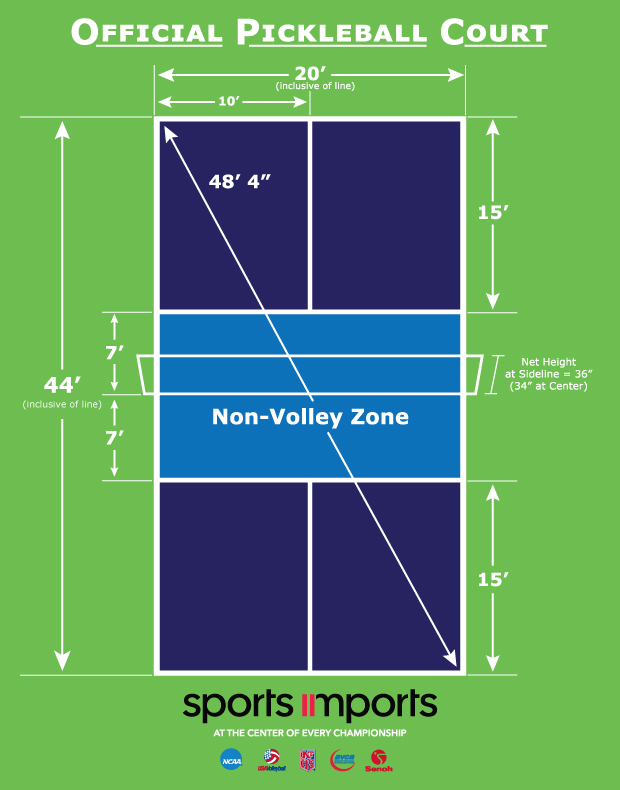
Credit: www.sportsimports.com
6. Add The Accessories
Once you have prepared the ground, built the base, and painted the surface of your backyard pickleball court, it’s time to add the finishing touches. With the right accessories, your court will be ready for hours of fun and competitive gameplay. In this section, we will discuss the key elements to complete your pickleball court and provide an enjoyable playing experience.
6.1 Install The Net And Posts
To get your pickleball court game-ready, installing a net and posts is essential. The standard pickleball net height is 34 inches at the center, measuring 22 feet wide. Follow these steps to properly install the net and posts:
- Start by measuring and marking the center point of each sideline with a chalk line.
- Attach the net posts securely on either side of the court, ensuring they are perpendicular and aligned with the centerline.
- Fasten the net onto the posts, making sure it is taut and at the correct height.
- Verify that the net is centered and extends evenly on both sides.
- Double-check the tension of the net to ensure a consistent playing experience.
6.2 Add Boundary Lines And Posts
Boundary lines are crucial for defining the boundaries of your pickleball court. To properly add the boundary lines and posts, follow these steps:
- Measure and mark the boundaries of your court, ensuring the dimensions are accurate.
- Use a string or chalk line to create straight lines along the court’s perimeter.
- Securely install boundary line posts at each corner, ensuring they are stable and flush with the ground.
- Attach the boundary lines to the posts, ensuring they are taught and straight.
- Confirm that the boundary lines are clear and easily distinguishable for players.
6.3 Optional: Install Lighting
If you plan on playing pickleball in the evenings or dimly lit areas, installing lighting can enhance visibility and extend playing time. Here are the steps to consider when installing lighting for your pickleball court:
- Consult with an electrician to determine the appropriate lighting system for your court size and location.
- Select high-quality, weather-resistant LED lighting fixtures for optimal performance and longevity.
- Ensure that the lighting is directed towards the court, providing even illumination throughout.
- Install the lighting poles securely, ensuring they are positioned outside the boundaries of the court.
- Test the lighting system to ensure consistent and suitable brightness for safe gameplay.
Congratulations! By adding the net and posts, boundary lines, and optional lighting to your pickleball court, you have created the perfect setup for a thrilling game. Now it’s time to gather your friends and family, grab your paddles, and enjoy the exciting sport of pickleball right in your own backyard.
Frequently Asked Questions On How To Build A Pickleball Court In Your Backyard
How Much Space Do I Need To Build A Pickleball Court In My Backyard?
You will need a flat space of at least 30 feet wide and 60 feet long to accommodate a standard-size pickleball court.
What Materials Are Required To Build A Pickleball Court In My Backyard?
To build a pickleball court, you will need materials like concrete or asphalt for the surface, fence panels, line markers, and a net system.
Can I Build A Pickleball Court On A Grass Surface In My Backyard?
While it’s possible to build a pickleball court on grass, a hard surface like concrete or asphalt is recommended for better gameplay and durability.
Is It Necessary To Have A Professional Contractor To Build A Pickleball Court?
While hiring a professional contractor ensures proper construction, you can build a pickleball court in your backyard as a DIY project if you have the necessary skills and tools.
How Much Does It Cost To Build A Pickleball Court In My Backyard?
The cost of building a pickleball court in your backyard depends on various factors, including the size, materials used, and whether you hire professionals. On average, it can range from $5,000 to $25,000.
Conclusion
Building a pickleball court in your backyard is a feasible and enjoyable project that can enhance your outdoor space. By following the steps outlined in this blog post, you can create a dedicated space for playing this popular sport. Remember to consider the dimensions, materials, and proper markings to ensure a professional-quality court.
With a little effort and planning, you can enjoy the fun and excitement of pickleball right in your own backyard.
Neil jacobson is an avid Pickleball enthusiast, writer, and coach dedicated to sharing the joy and intricacies of the sport. With 6 years of experience on the court and a passion for teaching, Courtney brings a unique perspective to his writing, offering practical insights and strategies for players of all levels. As a certified Pickleball coach, his mission is to inspire and empower individuals to excel in the game while fostering a sense of community within the Pickleball world. Through his articles, guides, and coaching sessions, Neil aims to elevate the playing experience and share the infectious enthusiasm that defines the Pickleball community.

